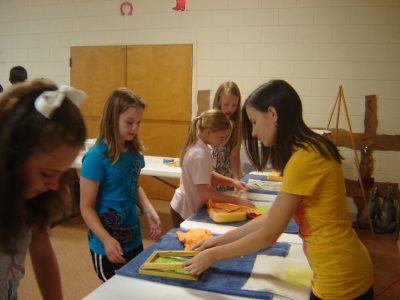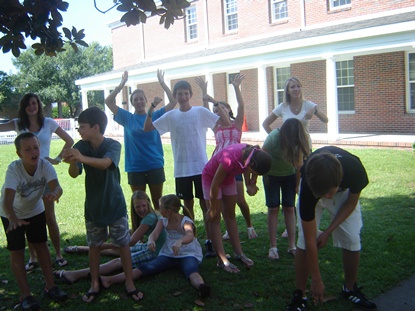Project Learning Tree activities great for teaching science concepts. They are excellent tools to teach life skills. We incorporated PLT activities in a summer leadership camp in Hahira, Georgia, and students learned valuable life lessons about leadership, teamwork, and volunteerism.
Leadership
A cross-section of a tree, or “tree cookie,” shows patterns of change in a tree’s life as well as changes in the area where it grows. This is one way to learn about tree growth. Students participated in PLT Activity 76 “Tree Cookies“ where they examined tree cross-sections to infer environmental conditions that may have affected the tree.
Students took the lessons learned in this activity and applied it to their own lives. They used crayons and paper plates to create their personal “tree cookies” to represent key elements of their own growth.
Then, students were challenged to continue growing by reaching out to members of their community. The students decided to express thanks to local leaders who provide essential community services. They walked to banks, the police station, the fire station, and city hall and distributed fresh baked “tree cookies” as they thanked members of the community for their service.
In this project, students also took the initiative to ask community members about their personal growth experiences. They learned that these civic leaders were once children too, with their careers beginning in the classroom. During one visit, Hahira City Manager, Jonathon Sumner shared with the students the following advice: “Leadership, like respect, is earned not given.”
Teamwork
Students learned about teamwork through PLT Activity 63 “Tree Factory.” In this activity, students became better acquainted with tree parts and their functionality by acting them out. Together, students represented heartwood supporting, xylem and phloem transporting, roots absorbing, leaves photosynthesizing, and bark protecting.
Ben, a sixth grader commented, “When we were doing the tree factory, we had to work together. Even though we didn’t have the same jobs, everyone’s job was important to keep the tree alive.”
Volunteerism
We used Giving Tree by Shel Silverstein and PLT Activity 13 “We All Need Trees” to introduce the concept of volunteerism to students. In this activity, students learned about the many different products we get from trees. They also learned to “give” as they began to understand the many benefits that trees provide.
To show the giving capacity of students, 20 camp participants volunteered at the local food bank. The students worked in teams to sort and organize food donations. They learned that they were a part of a larger organization that provides over 7,400 meals each week to the hungry in the local area, just as single trees work in concert to provide forest benefits.
Beyond the Camp
When the camp youth participated in a hands-on, fun, theme-based learning environment, they gained valuable skills to become future leaders.
After camp, we followed up with some of the participants. Several of them had begun volunteering with “Terrific Tuesdays,” a children’s program in Hahira, Georgia. These young leaders were role models as they presented PLT Activity 27 “Every Tree for Itself“ and PLT Activity 63 “Tree Factory.”
Watching these young leaders interact with the younger children as they taught them about trees was proof that PLT is just the resource to teach life skills.


